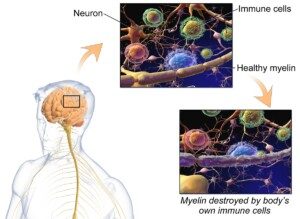Telling multiple sclerosis from restless leg syndrome?
Multiple sclerosis vs. restless leg syndrome: Is there really a way to know, without seeing a doctor, if what you’re experiencing is restless leg syndrome, as opposed to the more serious issue of multiple sclerosis?
Restless leg syndrome can be so troublesome that a person might actually wonder if he or she has multiple sclerosis.
So I asked Daniel Kantor, MD, director of the Neurology Residency Program, Florida Atlantic University, if there is a way to know that certain symptoms are far more likely to be just a bad case of restless leg syndrome, rather than a scarier case of multiple sclerosis.
Dr. Kantor explains: “Multiple sclerosis (MS) usually manifests itself in many ways, not simply as a problem with the feet at night and a need to move around to try to relieve this disturbing sensation.
“So, someone who only has symptoms of restless leg syndrome and nothing else, is less likely to have multiple sclerosis, than someone with many MS symptoms.”
Symptoms of Multiple Sclerosis
- Numbness or weakness in a limb
- Tingling or pain in the body
- Tremors
- Unsteady walking
- Lack of coordination
- Dizziness
- Fatigue
- Vision problem
- Pain with eye movement.

Multiple sclerosis. BruceBlaus, CC BY-SA 4.0/creativecommons.org/licenses/by-sa/4.0/Wikimedia Commons
Symptoms of RLS
In restless leg syndrome, the person typically feels “creepy crawlies” or crawling sensations under the skin of the lower limbs, that make keeping them motionless impossible.
Sometimes there aren’t any crawling, wormy or squirmy sensations under the skin, but the person still feels a compulsive need to keep the legs moving — all while trying to get some sleep or relax in a chair to read.
Keeping the legs still, gets very uncomfortable, and relief comes from continuously moving them.
However, restless leg syndrome does not produce numbness, pain or weakness, or other symptoms associated with multiple sclerosis, such as difficulty walking or vision problems.
Dr. Kantor says, “There does seem to be a higher prevalence of RLS in people with autoimmune diseases (such as MS) than the rest of the population.
“This can make it confusing when someone has multiple sclerosis and has restless leg syndrome symptoms — how can you know the difference?
“If someone has both MS and separately RLS, it is a good idea to undergo the regular RLS workup — such as having your iron tested, and if no other abnormality shows up, then you would probably treat the RLS symptoms in someone with MS just as you would treat it in someone without MS.”
There is no evidence that having restless leg syndrome puts you at risk for developing multiple sclerosis.

Dr. Kantor is also President Emeritus, Florida Society of Neurology.
 Lorra Garrick has been covering medical, health and personal security topics for many years, having written thousands of feature articles for a variety of print magazines and websites. She is also a former ACE-certified personal trainer.
Lorra Garrick has been covering medical, health and personal security topics for many years, having written thousands of feature articles for a variety of print magazines and websites. She is also a former ACE-certified personal trainer.
.



























